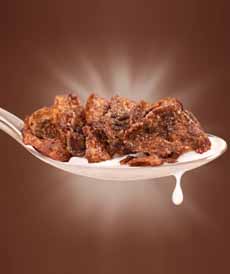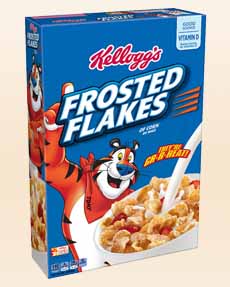PRODUCT: New Chocolate Frosted Flakes From Kellogg’s

Chocolate Frosted Flakes joins the family, begun in 1953 with original Frosted Flakes. The line now inclues Kellogg’s Cinnamon Frosted Flakes, Kellogg’s Frosted Flakes Chocolate with Marshmallows, Kellogg’s Frosted Flakes Choco Zucaritas, and Kellogg’s Frosted Flakes with Marshmallows (all photos courtesy Kellogg’s). |
“They’re grr-r-eat!” says Tony The Tiger, the cartoon character spokesman for Kellogg’s Frosted Flakes. Now, there’s a new addition to the Frosted Flakes portfolio, one that some people may find even grr-r-eater: Kellogg’s Chocolate Frosted Flakes. The product, which launches in November at participating retailers nationwide, coats the flakes with cocoa powder. The result: the same sweet, crunchy Frosted Flakes experience with chocolate. Imagine what the cocoa does to the cereal milk! Kellogg’s developed Chocolate Frosted Flakes by working with fans, testing how different types of cocoas interacted with both the cereal flakes and the milk left at the bottom of the bowl (“cereal milk”). Keep your eye out for them; and pick up extra boxes for sharing. Cereal flakes were invented by Dr. John Kellogg and his brother Will Kellogg in 1894, at their Battle Creek, Michigan, sanitarium. They sought to create new forms of foods that were more nutritious and more easily digestible. They were experimenting with wheat, trying to make a more digestible substitute for bread, when they accidentally left a batch of cooked wheat in the kitchen as they attended to some pressing matters at the sanitarium. When they returned the next day, they found that the wheat had gone become hard and solid. Being on a strict budget, they decided to continue to process it by forcing it through rollers, hoping to obtain long sheets of the dough. To their surprise, what they found instead were flakes, which they toasted and served to their patients. A success! After four more years of trial and effort, the Kelloggs successfully applied the process to corn. However, they only sold their cornflakes by mail as a health food, to patients and former patients. Dr. Kellogg was a man of medicine, not interested in the greater commercial opportunities. general public. However, one of his patients, C.W. Post, stole Kellogg’s recipes and turned them into consumer products. Will Kellogg, the business brother, finally expanded the cereal business in 1903. Kellogg’s Corn Flakes grabbed the majority share of the corn flakes market, and their product has remained the #1 corn flake ever since. |
|
|
For 50 years, Kellogg’s Corn Flakes were the best-selling dry cereal in the U.S. Post Toasties, the Post version of corn flakes, were #2 (the Post product is now discontinued). On To Frosted Flakes In 1948, executives at Post Cereals (by then, part of General Foods, itself now part of Kraft Foods) noticed how well a sugar-coated cereal called Ranger Joe Popped Wheat Honnies was selling. They began developing their own sugar-coated wheat puffs, but it raised a serious moral dilemma for Post. At the time, all major cereal makers were focused on healthy food—the reason dry cereal was created in the first place. And even back then, it was known that sugar wasn’t great for children. Proponents of pre-sweetened cereal maintained, among other arguments, that adding a controlled amount of sugar during manufacturing was preferable to kids spooning on too much sugar from the sugar bowl. That was the rationale of Popped Wheat Honnies, the first sugar-coated cereal. In the end, they company was certain that that the sugar-coated cereal would be a big revenue generator; and the cereal was launched. This time, Kellogg’s followed Post. Kellogg’s Frosted Flakes, sugar-coated corn flakes, was launched in 1952 as Sugar Frosted Flakes. The word “sugar” was dropped from the name in 1983, as Americans began to become more aware of the downside of all that added sugar. Tony The Tiger was not a shoe-in. The advertising team recommended four animals that could appeal to children: an elephant, a gnu, a kangaroo and a tiger. The tiger was included because it was a symbol of energy, according to an art director who worked on the project. A TV commercial writer then named them all: Elmo the Elephant, Newt the Gnu, Katy the Kangaroo and Tony the Tiger. Jingle writers created a jingle for each animal. Tony’s four-line jingle ended with “They’re Grr-r-eat!” Elmo and Newt were dropped from production, but Tony and Katy appeared on separate boxes on the store shelves. Tony’s packages flew off the shelves. Alas, Kay’s just sat there…and was quickly retired. The company focused its energies exclusively on Tony, and the rest is history. (Source) |
||




